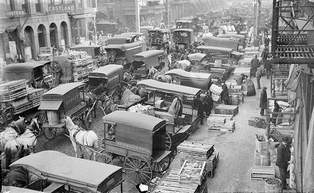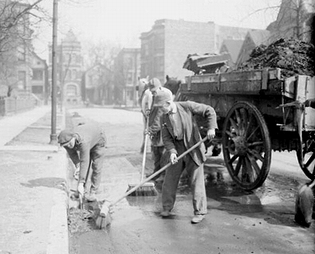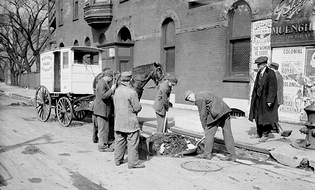 Excellent -- and very interesting -- question!
Excellent -- and very interesting -- question!
Q&A Questions and Answers:
As a horse owner/rider, I realize how very much manure even one horse produces, and how often they defecate - while standing as well as when being ridden. I love all those good old Western TV shoes: Cheyenne, The Virginian, High Chaparral, Bonanza, Have Gun Will Travel. I cannot help but notice how in ALL those shows, all the town streets are filled with horses being ridden pulling wagons yet there is not a pile of manure in sight - the dirt roads all look swept clean. Also, when it shows the cowboys riding their horses, it never shows a horse defecating. I realize that all this is done for aesthetic sake, for a pleasing vista.
My question is two-fold:
I thank you for your time!
ANSWER:
 Excellent -- and very interesting -- question!
Excellent -- and very interesting -- question!
Manure disposal has always been a big problem where horses are concerned. Not only does horse manure have a rather strong aroma, but it also generates a healthy crop of flies and other bugs.
On to your two questions...
(1) How exactly did real Old West towns deal with all the manure in their streets?
It wasn't just the Old West towns that had problems with manure disposal. Imagine the situation that confronted cities like New York and Chicago, where horses produced hundreds of tons of waste a week. And it wasn't just manure that had to be dealt with... if not removed or treated, horse urine could quickly generate huge quantities of eye-stinging ammonia in the air.
 In smaller towns, shopkeepers and other townsfolk kept manure forks and scoop shovels handy for removing unsightly deposits. It was simply a regular part of building maintenance -- just as mowing a lawn is today. In incorporated areas, such maintenance was a routine city function, with waste removal an often unnoticed background activity. City street crews were often supplemented with work crews from local jails or prisons. (See, for example, the young prisoners in the photos from the Chicago Daily News at right.)
In smaller towns, shopkeepers and other townsfolk kept manure forks and scoop shovels handy for removing unsightly deposits. It was simply a regular part of building maintenance -- just as mowing a lawn is today. In incorporated areas, such maintenance was a routine city function, with waste removal an often unnoticed background activity. City street crews were often supplemented with work crews from local jails or prisons. (See, for example, the young prisoners in the photos from the Chicago Daily News at right.)
After removing the heavy stuff, a water wagon would wash the remaining solids -- and the urine -- down the sewer system. There still remained the problem of where to put all of that stuff. Some went to fertilize local farms, but some also was dumped in oceans, large lakes, and rivers -- thus creating giant pollution problems. Even the waste that went into the storm sewers contributed to algae bloom and other water pollution problems.
Is it any wonder that people accepted the "horseless carriage" so quickly (even with the smelly exhaust it generated)?
 (2) How did the TV shows about the Old West deal with all the manure produced on their shows during filming?
(2) How did the TV shows about the Old West deal with all the manure produced on their shows during filming?
In film-making there's another problem on top of the routine waste-removal situation: continuity. Scenes that supposedly take place at the same time may actually be shot hours, or even days, apart. You can't have a pile of manure suddenly appearing and disappearing in a scene. That's why they hire folks as set dressers, greensmen, etc., to keep the set looking the same from one shot to the next. With a Western, part of that job involves removing any little deposits left by the equine cast members.
![]() Return to Questions and Answers Index
Return to Questions and Answers Index
![]() Return to the "Learning More About Horses..." page
Return to the "Learning More About Horses..." page
COPYRIGHT © 2010 BOB LEMEN, GRAND RAPIDS,
MINNESOTA. ALL RIGHTS RESERVED.
The contents of this document are not for reproduction.